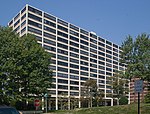Homewood Field
1906 establishments in MarylandAmerican football venues in MarylandChesapeake BayhawksCollege field hockey venues in the United StatesCollege football venues ... and 14 more
College lacrosse venues in the United StatesCollege soccer venues in the United StatesFormer Major League Lacrosse venuesJohns Hopkins Blue Jays footballJohns Hopkins Blue Jays men's lacrosseLacrosse venues in MarylandMaryland building and structure stubsMaryland sport stubsNCAA Division I men's lacrosse tournament venuesPremier Lacrosse League venuesSoccer venues in MarylandSouthern United States sports venue stubsSports venues completed in 1906Sports venues in Baltimore

Homewood Field is the athletics stadium of the Johns Hopkins University in Baltimore, Maryland.
Excerpt from the Wikipedia article Homewood Field (License: CC BY-SA 3.0, Authors, Images).Homewood Field
North Charles Street, Baltimore
Geographical coordinates (GPS) Address Website Nearby Places Show on map
Geographical coordinates (GPS)
| Latitude | Longitude |
|---|---|
| N 39.333611111111 ° | E -76.620833333333 ° |
Address
Johns Hopkins University
North Charles Street 3400
21218 Baltimore
Maryland, United States
Open on Google Maps






